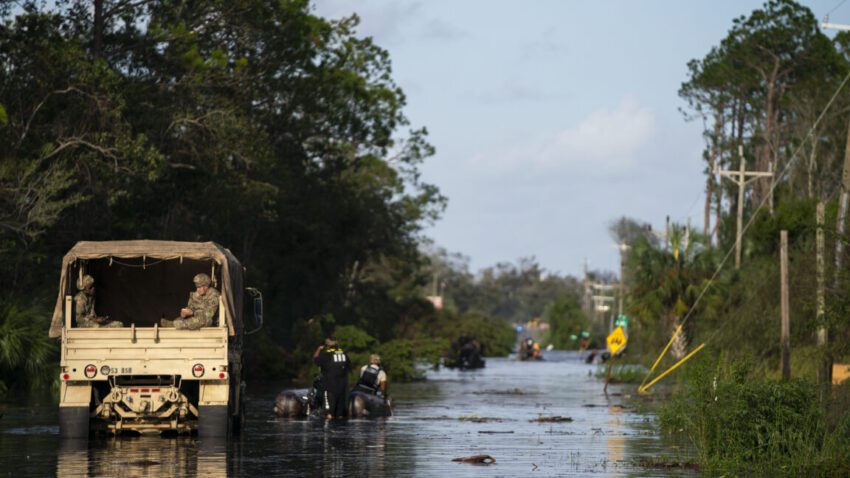
natural disasters are a rising burden for The National Guard has increasingly become a vital resource in responding to natural disasters, with recent reports indicating a significant rise in service days dedicated to such emergencies.
natural disasters are a rising burden for
Overview of National Guard Deployments
According to a recent Pentagon report submitted to Congress, the National Guard has logged over 400,000 member service days annually over the past decade in response to hurricanes, wildfires, floods, and other natural disasters. This statistic underscores the growing reliance on the National Guard as a first responder in times of crisis.
Daily Deployment Statistics
The data reveals that, on average, approximately 1,100 National Guard troops are deployed each day across the United States for disaster response operations. This consistent deployment highlights not only the frequency of natural disasters but also the increasing demands placed on the National Guard to assist in managing these emergencies.
Types of Natural Disasters Responded To
The National Guard’s involvement spans a wide range of natural disasters, including:
- Hurricanes: The National Guard plays a crucial role in pre-storm preparations, evacuation efforts, and post-storm recovery.
- Wildfires: Troops are often deployed to assist with firefighting efforts, protecting homes, and evacuating residents.
- Floods: National Guard units provide support in rescue operations and aid in recovery efforts after flooding events.
- Earthquakes: In the event of seismic activity, the National Guard assists with search and rescue operations and infrastructure assessments.
Case Studies of Recent Deployments
Several recent events illustrate the National Guard’s critical role in disaster response:
- Hurricane Ida (2021): The National Guard mobilized thousands of troops to assist in rescue operations, provide medical support, and help restore essential services in the aftermath of the storm.
- California Wildfires (2020): During one of the worst wildfire seasons on record, the National Guard was deployed to assist local firefighting efforts, protect communities, and provide logistical support.
- Texas Winter Storm (2021): In response to severe winter weather, the National Guard helped distribute food, water, and blankets to affected residents, showcasing their versatility in various disaster scenarios.
Implications of Increased Deployments
The rising number of service days dedicated to disaster response has several implications for the National Guard and the communities they serve.
Resource Allocation and Readiness
As natural disasters become more frequent and severe, the National Guard must allocate resources effectively to ensure readiness. This includes:
- Training: Increased training programs are necessary to prepare troops for diverse disaster scenarios, ensuring they can respond effectively when called upon.
- Equipment: Investment in specialized equipment, such as firefighting gear and rescue vehicles, is essential to enhance operational capabilities.
- Coordination: Improved coordination with local and federal agencies can streamline response efforts and maximize the impact of deployments.
Impact on Personnel
The sustained deployment of National Guard troops for disaster response can also affect personnel. Prolonged service can lead to:
- Burnout: Continuous deployments may contribute to mental and physical fatigue among service members, necessitating support systems to address their well-being.
- Retention Challenges: High operational tempo can impact retention rates, as service members may seek opportunities with less demanding schedules.
Stakeholder Reactions
The report has elicited various reactions from stakeholders, including government officials, community leaders, and military personnel.
Government Officials
Many government officials have expressed concern over the increasing burden on the National Guard. Some have called for:
- Increased Funding: To support the National Guard’s expanding role, officials advocate for increased federal funding to enhance training, equipment, and personnel support.
- Policy Revisions: Some lawmakers are pushing for policy changes to better integrate the National Guard into disaster response frameworks at local, state, and federal levels.
Community Leaders
Community leaders have praised the National Guard’s efforts but also emphasize the need for sustainable solutions. They argue that:
- Local Resources: Communities should invest in local emergency response capabilities to reduce reliance on the National Guard for every disaster.
- Public Awareness: Increased public awareness about disaster preparedness can help mitigate the impact of natural disasters, potentially reducing the need for extensive National Guard deployments.
Military Personnel
Military personnel have voiced their commitment to serving during disasters but have also highlighted the need for:
- Support Systems: Enhanced mental health resources and support networks for service members returning from deployments.
- Work-Life Balance: The importance of maintaining a balance between military duties and personal life to ensure long-term retention and morale.
Future Outlook
Looking ahead, the National Guard’s role in disaster response is likely to evolve further. Several factors will shape this future:
Climate Change
As climate change continues to exacerbate the frequency and intensity of natural disasters, the National Guard may face an increasing number of deployments. This necessitates:
- Adaptation Strategies: Developing strategies to adapt to changing disaster patterns and prepare for new types of emergencies.
- Collaboration with Scientists: Engaging with climate scientists and emergency management experts to better understand and anticipate future risks.
Technological Advancements
Technological advancements will also play a crucial role in enhancing the National Guard’s disaster response capabilities. Innovations may include:
- Drones: Utilizing drones for aerial assessments and search-and-rescue operations can improve response times and situational awareness.
- Data Analytics: Leveraging data analytics to predict disaster patterns and optimize resource allocation during emergencies.
Conclusion
The National Guard’s increasing involvement in disaster response highlights the growing challenges posed by natural disasters in the United States. As the frequency of these events rises, so too does the burden on the National Guard. Addressing this issue requires a multifaceted approach involving enhanced training, resource allocation, and collaboration among various stakeholders. By investing in these areas, the National Guard can continue to fulfill its critical role in safeguarding communities during times of crisis.
Source: Original report
Was this helpful?
Last Modified: October 8, 2025 at 12:36 am
0 views














